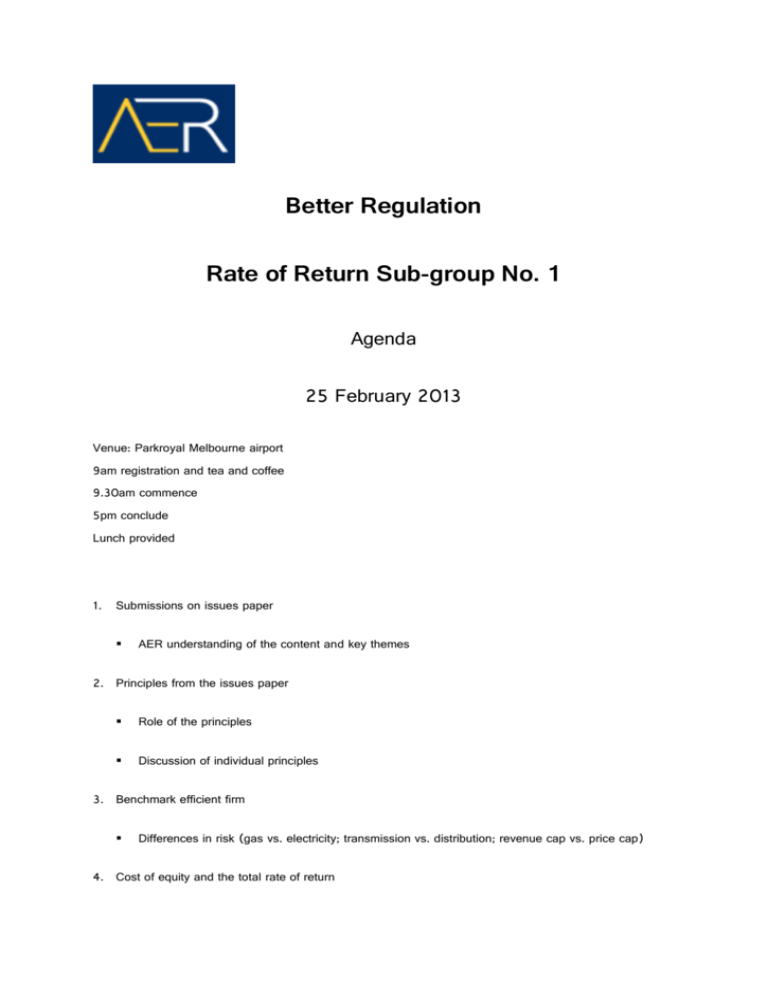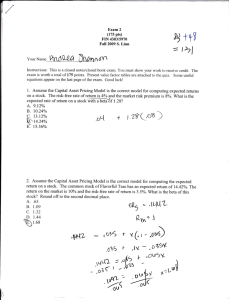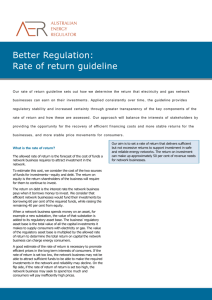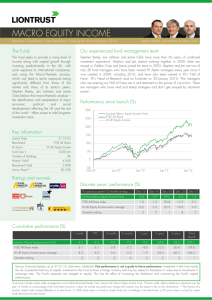Rate of return guidelines
advertisement

Better Regulation Rate of Return Sub-group No. 1 Agenda 25 February 2013 Venue: Parkroyal Melbourne airport 9am registration and tea and coffee 9.30am commence 5pm conclude Lunch provided 1. Submissions on issues paper AER understanding of the content and key themes 2. Principles from the issues paper Role of the principles Discussion of individual principles 3. Benchmark efficient firm Differences in risk (gas vs. electricity; transmission vs. distribution; revenue cap vs. price cap) 4. Cost of equity and the total rate of return Potential approaches: i. Primary cost of equity model with cross checks on overall rate of return (current AER approach) ii. Multi-cost of equity model approach (ENA approach; APIA approach; other approaches) iii. Ofgem’s use of financibility credit metrics and return on regulatory equity (RoRE) analysis Factors for consideration: i. Balancing predictability and flexibility ii. At what point is judgement applied (parameter-level, model-level, cost of equity / debt-level, total return-level, each level) iii. Whether appropriateness of certain models are likely to change between guidelines in different market conditions iv. Separate consideration of equity and debt with / or without additional consideration of the overall rate of return 5. Other business Better Regulation Rate of Return Sub-group No. 2 Agenda 26 February 2013 Venue: Parkroyal Melbourne airport 9am registration and tea and coffee 9.30am commence 5pm conclude Lunch provided 1. Submissions on issues paper AER understanding of the content and key themes 2. Principles from the issues paper (recap from sub-group 1) Role of the principles Discussion of individual principles 3. Return on debt Efficient benchmark firm: i. Pros/cons of on-the-day approach (i.e. consistent with notional new entrant) vs trailing average approach (i.e. recognition of NSP’s existing debt) ii. Desirability of conceptual approach to Cost of Debt being consistent with conceptual approach to Cost of Equity. How? Factors for consideration when setting allowance i. Ownership ii. Size (are size differences sufficient to justify different approaches for the benchmark company? i.e. when abstracting from ownership type) iii. Typical maturity iv. Credit rating Implementation: i. Data sources (i.e. Bloomberg vs AER-produced) ii. What are the appropriate comparators? iii. How to use international evidence (e.g. Australian issuances in US market) iv. How to reconcile use of the benchmark company against NSPs’ view to have an approach that matches their particular circumstances? Non-regulated infrastructure provider with long lived assets as benchmark? o But is this the appropriate comparable? Trailing average (or portfolio) approach–received support in submissions i. Do benefits of weighted average (potentially more reflective of company circumstances) outweigh costs (complexity, resource requirement and potential for unintended consequences)? What characterises efficient debt and risk management practices? Debt to equity ratio Non-regulated infrastructure provider with long lived assets as benchmark? o Multiple trailing average approaches in guidelines? o Is this the appropriate comparator? No consensus on the “best “ approach Multiple benchmarks for different businesses i. Is this feasible? What does this mean? 4. Other business











